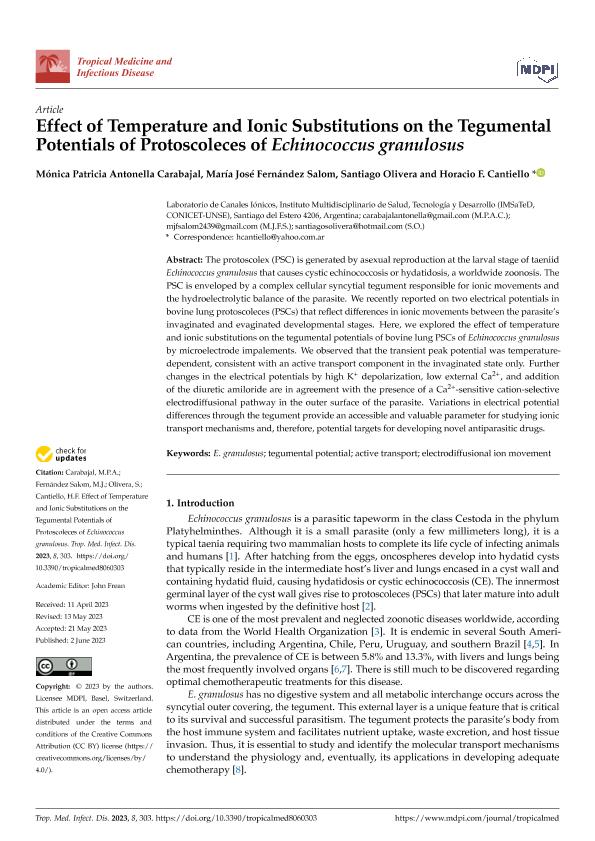Artículo
Effect of Temperature and Ionic Substitutions on the Tegumental Potentials of Protoscoleces of Echinococcus granulosus
Carabajal, Monica Patricia Antonella ; Fernandez Salom, Maria Jose
; Fernandez Salom, Maria Jose ; Olivera, Santiago Roberto; Cantiello, Horacio Fabio
; Olivera, Santiago Roberto; Cantiello, Horacio Fabio
 ; Fernandez Salom, Maria Jose
; Fernandez Salom, Maria Jose ; Olivera, Santiago Roberto; Cantiello, Horacio Fabio
; Olivera, Santiago Roberto; Cantiello, Horacio Fabio
Fecha de publicación:
06/2023
Editorial:
Multidisciplinary Digital Publishing Institute
Revista:
Tropical Medicine and Infectious Disease
ISSN:
2414-6366
Idioma:
Inglés
Tipo de recurso:
Artículo publicado
Clasificación temática:
Resumen
The protoscolex (PSC) is generated by asexual reproduction at the larval stage of taeniid Echinococcus granulosus that causes cystic echinococcosis or hydatidosis, a worldwide zoonosis. The PSC is enveloped by a complex cellular syncytial tegument responsible for ionic movements and the hydroelectrolytic balance of the parasite. We recently reported on two electrical potentials in bovine lung protoscoleces (PSCs) that reflect differences in ionic movements between the parasite’s invaginated and evaginated developmental stages. Here, we explored the effect of temperature and ionic substitutions on the tegumental potentials of bovine lung PSCs of Echinococcus granulosus by microelectrode impalements. We observed that the transient peak potential was temperature-dependent, consistent with an active transport component in the invaginated state only. Further changes in the electrical potentials by high K+ depolarization, low external Ca2+, and addition of the diuretic amiloride are in agreement with the presence of a Ca2+-sensitive cation-selective electrodiffusional pathway in the outer surface of the parasite. Variations in electrical potential differences through the tegument provide an accessible and valuable parameter for studying ionic transport mechanisms and, therefore, potential targets for developing novel antiparasitic drugs.
Archivos asociados
Licencia
Identificadores
Colecciones
Articulos (IMSATED)
Articulos de INSTITUTO MULTIDISCIPLINARIO DE SALUD, TECNOLOGIA Y DESARROLLO
Articulos de INSTITUTO MULTIDISCIPLINARIO DE SALUD, TECNOLOGIA Y DESARROLLO
Citación
Carabajal, Monica Patricia Antonella; Fernandez Salom, Maria Jose; Olivera, Santiago Roberto; Cantiello, Horacio Fabio; Effect of Temperature and Ionic Substitutions on the Tegumental Potentials of Protoscoleces of Echinococcus granulosus; Multidisciplinary Digital Publishing Institute; Tropical Medicine and Infectious Disease; 8; 6; 6-2023; 1-13
Compartir
Altmétricas



